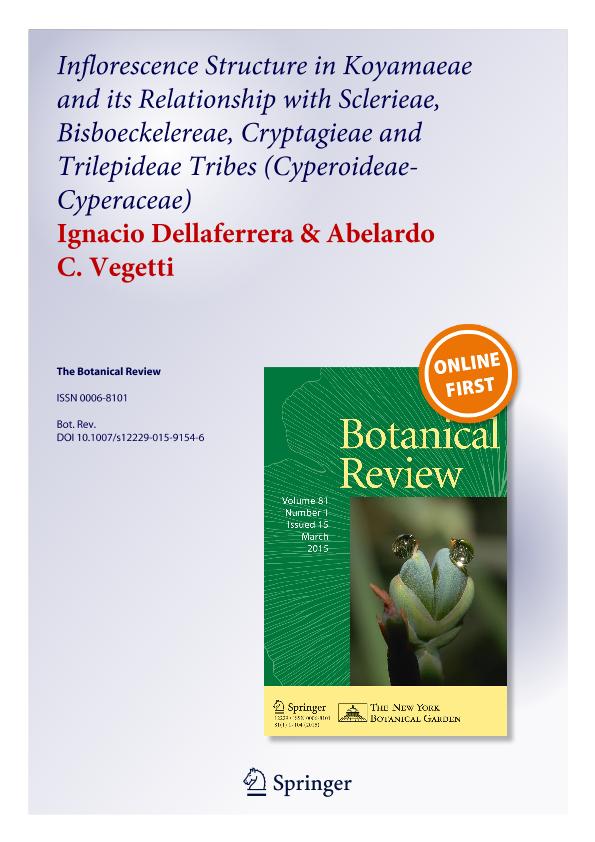Mostrar el registro sencillo del ítem
dc.contributor.author
Dellaferrera, Ignacio Miguel

dc.contributor.author
Vegetti, Abelardo Carlos

dc.date.available
2018-05-03T19:36:59Z
dc.date.issued
2015-06
dc.identifier.citation
Dellaferrera, Ignacio Miguel; Vegetti, Abelardo Carlos; Inflorescence Structure in Koyamaeae and its Relationship with Sclerieae, Bisboeckelereae, Cryptagieae and Trilepideae Tribes (Cyperoideae-Cyperaceae); Springer; Botanical Review; 81; 2; 6-2015; 179-188
dc.identifier.issn
0006-8101
dc.identifier.uri
http://hdl.handle.net/11336/44035
dc.description.abstract
This paper aims to interpret and characterize the inflorescence of Koyamaeae tribe from the typological point of view in order to establish homologies and promote comparative studies and the use of inflorescence characters in future phylogenetic studies. The Koyamaeae tribe is comprised of one monotypic Koyamaea W. Thomas &Davidse genus, with K. neblinensisW. Thomas&Davidse. Koyamaea neblinensis has a synflorescence type II and/or type III made up by a many-noded culm, covered by sheaths, usually unbranched (synflorescence type II), but occasionallywith 1?2 branches from the upper half (synflorescence type III). The inflorescence of Koyamaea shows a main axis leading to a terminal spikelet (main florescence) and a primary branch (primary paraclade) arising from the axillary bud of the single involucral bract. Accordingly, the inflorescence is composed of the main florescence and a highly reduced paracladial zone. This paracladial zone is reduced to one node where a single primary paraclade is inserted. This primary paraclade consists of a short hypopodium, a prophyll, an epipodium and a terminal spikelet (or coflorescence). The axillary bud of the prophyll develops a secondary branch (secondary Paraclade) with a similar structure to that of the primary paraclade. All subsequent higher-order branches also arise in the axils of prophylls. Inflorescence characters of this tribe are discussed in relation to related tribes Sclerieae, Bisboeckelereae, Cryptangieae and Trilepideae (sensu Goetghebeur, 1998).
dc.format
application/pdf
dc.language.iso
eng
dc.publisher
Springer

dc.rights
info:eu-repo/semantics/openAccess
dc.rights
Atribución-NoComercial-CompartirIgual 2.5 Argentina (CC BY-NC-SA 2.5 AR)
dc.rights.uri
https://creativecommons.org/licenses/by-nc-sa/2.5/ar/
dc.subject
Koyamaea
dc.subject
Cyperoideae
dc.subject
Cyperaceae
dc.subject
Inflorescence
dc.subject.classification
Otras Ciencias Biológicas

dc.subject.classification
Ciencias Biológicas

dc.subject.classification
CIENCIAS NATURALES Y EXACTAS

dc.title
Inflorescence Structure in Koyamaeae and its Relationship with Sclerieae, Bisboeckelereae, Cryptagieae and Trilepideae Tribes (Cyperoideae-Cyperaceae)
dc.type
info:eu-repo/semantics/article
dc.type
info:ar-repo/semantics/artículo
dc.type
info:eu-repo/semantics/publishedVersion
dc.date.updated
2018-04-27T20:26:15Z
dc.journal.volume
81
dc.journal.number
2
dc.journal.pagination
179-188
dc.journal.pais
Alemania

dc.journal.ciudad
Berlin
dc.description.fil
Fil: Dellaferrera, Ignacio Miguel. Universidad Nacional del Litoral. Facultad de Ciencias Agrarias; Argentina. Consejo Nacional de Investigaciones Científicas y Técnicas. Centro Científico Tecnológico Conicet - Santa Fe; Argentina
dc.description.fil
Fil: Vegetti, Abelardo Carlos. Universidad Nacional del Litoral. Facultad de Ciencias Agrarias; Argentina. Consejo Nacional de Investigaciones Científicas y Técnicas. Centro Científico Tecnológico Conicet - Santa Fe; Argentina
dc.journal.title
Botanical Review

dc.relation.alternativeid
info:eu-repo/semantics/altIdentifier/url/https://link.springer.com/article/10.1007%2Fs12229-015-9154-6
dc.relation.alternativeid
info:eu-repo/semantics/altIdentifier/doi/http://dx.doi.org/10.1007/s12229-015-9154-6
Archivos asociados
